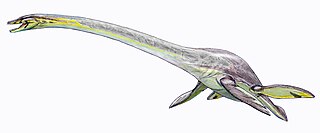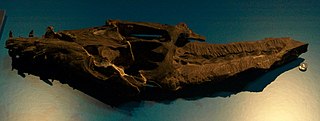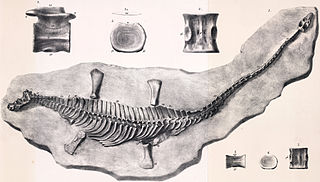| |||
|---|---|---|---|
| +... | |||
Paleontology or palaeontology is the study of prehistoric life forms on Earth through the examination of plant and animal fossils . [1] This includes the study of body fossils, tracks ( ichnites ), burrows , cast-off parts, fossilised feces ( coprolites ), palynomorphs and chemical residues . Because humans have encountered fossils for millennia, paleontology has a long history both before and after becoming formalized as a science . This article records significant discoveries and events related to paleontology that occurred or were published in the year 1876.
| |||||||||||||||||||||
| ||||||||||||||||||||
| |||||||||||||||||||||||||
| Name | Status | Authors | Age | Location | Notes | Images |
|---|---|---|---|---|---|---|
Valid | Owen | 255 Millions of years ago. | Box-Headed animal |  | ||
Valid | Owen | 257 Millions of years ago. |  | |||
Valid | Owen | 257 Millions of years ago. | A Gorgonopsian. |  | ||
Valid | Owen | 251 Millions of years ago. |  | |||
Valid | Owen | 261 Millions of years ago. | A Dome-headed Dinocephalian. |  | ||
Valid | Owen | 255 Millions of years ago. |  | |||
Valid | Owen | 261 Millions of years ago. | Titanic crocodile. |  | ||

Plesiosauroidea is an extinct clade of carnivorous marine reptiles. They have the snake-like longest neck to body ratio of any reptile. Plesiosauroids are known from the Jurassic and Cretaceous periods. After their discovery, some plesiosauroids were said to have resembled "a snake threaded through the shell of a turtle", although they had no shell.

Pliosauroidea is an extinct clade of plesiosaurs, known from the earliest Jurassic to early Late Cretaceous. They are best known for the subclade Thalassophonea, which contained crocodile-like short-necked forms with large heads and massive toothed jaws, commonly known as pliosaurs. More primitive non-thalassophonean pliosauroids resembled plesiosaurs in possessing relatively long necks and smaller heads. They originally included only members of the family Pliosauridae, of the order Plesiosauria, but several other genera and families are now also included, the number and details of which vary according to the classification used.

Macroplata is an extinct genus of Early Jurassic rhomaleosaurid plesiosaur which grew up to 4.65 metres (15.3 ft) in length. Like other plesiosaurs, Macroplata probably lived on a diet of fish, using its sharp needle-like teeth to catch prey. Its shoulder bones were fairly large, indicating a powerful forward stroke for fast swimming. Macroplata also had a relatively long neck, twice the length of the skull, in contrast to pliosaurs. It is known from a nearly complete skeleton NHMUK PV R5488 from the Blue Lias Formation (Hettangian) of Harbury, Warwickshire, UK.

Rhomaleosaurus is an extinct genus of Early Jurassic rhomaleosaurid pliosauroid known from Northamptonshire and from Yorkshire of the United Kingdom. It was first named by Harry Seeley in 1874 and the type species is Rhomaleosaurus cramptoni. It was one of the earliest large marine reptile predators which hunted in the seas of Mesozoic era, measuring about 7 metres (23 ft) long. Like other pliosaurs, Rhomaleosaurus fed on ichthyosaurs, ammonites and other plesiosaurs.

Microcleidus is an extinct genus of sauropterygian reptile belonging to the Plesiosauroidea. The species has 40 neck vertebrae and a short tail of 28 vertebrae. Fossils of the genus have been found in France, the Posidonia Shale in Germany and Luxembourg, and the Alum Shale Formation of England.

Polycotylidae is a family of plesiosaurs from the Cretaceous, a sister group to Leptocleididae. They are known as false pliosaurs. Polycotylids first appeared during the Albian stage of the Early Cretaceous, before becoming abundant and widespread during the early Late Cretaceous. Several species survived into the final stage of the Cretaceous, the early Maastrichtian around 72 million years ago. The possible latest surviving member Rarosaurus from the late Maastrichtian is more likely a crocodylomorph.

Thalassiodracon (tha-LAS-ee-o-DRAY-kon) is an extinct genus of plesiosauroid from the Pliosauridae that was alive during the Late Triassic-Early Jurassic (Rhaetian-Hettangian) and is known exclusively from the Lower Lias of England. The type and only species, is Thalassiodracon (Plesiosaurus) hawkinsii.

Leptocleidus is an extinct genus of plesiosaur, belonging to the family Leptocleididae. It was a small plesiosaur, measuring only up to 3 m (9.8 ft).
Paleontology or palaeontology is the study of prehistoric life forms on Earth through the examination of plant and animal fossils. This includes the study of body fossils, tracks (ichnites), burrows, cast-off parts, fossilised feces (coprolites), palynomorphs and chemical residues. Because humans have encountered fossils for millennia, paleontology has a long history both before and after becoming formalized as a science. This article records significant discoveries and events related to paleontology that occurred or were published in the year 1857.

Augustasaurus is an extinct genus of sauropterygians that lived during the Anisian stage of the Middle Triassic in what is now North America. Only one species is known, A. hagdorni, described in 1997 from fossils discovered in the Favret Formation, Nevada, USA.

Hauffiosaurus is an extinct genus of Early Jurassic pliosaurid plesiosaur known from Holzmaden of Germany and from Yorkshire of the United Kingdom. It was first named by Frank Robin O’Keefe in 2001 and the type species is Hauffiosaurus zanoni. In 2011, two additional species were assigned to this genus: H. longirostris and H. tomistomimus.
Eurycleidus is an extinct genus of large-bodied rhomaleosaurid known from the Early Jurassic period of the United Kingdom. It contains a single species, E. arcuatus.

Eretmosaurus is an extinct genus of plesiosaur from the Early and Middle Jurassic of England and Russia. Two species are known: E. rugosus and E. dubius.

The Whitby Mudstone is a Toarcian geological formation in Yorkshire and Worcestershire, England. The formation, part of the Lias Group, is present in the Cleveland and Worcester Basins and the East Midlands Shelf.

Meyerasaurus is an extinct genus of rhomaleosaurid plesiosaur known from the Early Jurassic of Holzmaden, Baden-Württemberg in southwestern Germany.
Paleontology or palaeontology is the study of prehistoric life forms on Earth through the examination of plant and animal fossils. This includes the study of body fossils, tracks (ichnites), burrows, cast-off parts, fossilised feces (coprolites), palynomorphs and chemical residues. Because humans have encountered fossils for millennia, paleontology has a long history both before and after becoming formalized as a science. This article records significant discoveries and events related to paleontology that occurred or were published in the year 2011.

Lusonectes is an extinct genus of microcleidid plesiosaur from the Early Jurassic (Toarcian) São Gião Formation of Portugal.

Microcleididae is an extinct family of basal plesiosauroid plesiosaurs from the Early Jurassic of France, Germany, Portugal and the United Kingdom. Currently, the oldest and the most known microcleidid is Eretmosaurus from the middle Sinemurian of the United Kingdom. Microcleididae was formally named and described by Roger B. J. Benson, Mark Evans and Patrick S. Druckenmiller in 2012.

This timeline of plesiosaur research is a chronologically ordered list of important fossil discoveries, controversies of interpretation, taxonomic revisions, and cultural portrayals of plesiosaurs, an order of marine reptiles that flourished during the Mesozoic Era. The first scientifically documented plesiosaur fossils were discovered during the early 19th century by Mary Anning. Plesiosaurs were actually discovered and described before dinosaurs. They were also among the first animals to be featured in artistic reconstructions of the ancient world, and therefore among the earliest prehistoric creatures to attract the attention of the lay public. Plesiosaurs were originally thought to be a kind of primitive transitional form between marine life and terrestrial reptiles. However, now plesiosaurs are recognized as highly derived marine reptiles descended from terrestrial ancestors.